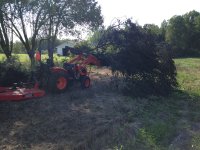The consensus used to be that the earth was flat and we know how that worked out. Here's my 2 cents. Others may disagree. However, all tests I've seen in this area confirm what I state below.
Same model with gear vs HST and same engine, gear will have more PTO hp and much more draw bar hp. You can confirm the difference in PTO hp by looking at published specs. There are a few Nebraska tests out there that show the even greater difference in draw bar hp gear vs HST. The difference is quite large and most people don't understand this because it is not a spec that is frequently published for small tractors. Given this difference, there is no doubt that a gear tractor should be the choice for field work. Add in that for the price of HST you can typically get a bigger engine instead and available hp for field work at a price point is much higher with gear.
I'll take a stab at the turbo question but I have never done/seen any testing in this area and I'm sure there are others who can shed more light on this. In short... it depends...
Take any normally aspirated diesel engine and make it spin a turbo and it will suck more fuel (it takes power to spin that turbo!) until you load it so much that the normally aspirated versions burn efficiency suffers enough (due to not enough oxygen) to offset the mechanical load of the turbo version which has much more oxygen available to it. Part of the efficiency gained in turbo applications often comes from down sizing the engine for a given hp so that when at low pressure you're running a smaller air pump (and engine is just an air pump) and when needed it becomes a bigger air pump by increasing air pressure and getting more oxygen through the engine. This kind of gives you the efficiency of the small engine when full power isn't needed, and the ability to become a bigger air pump by increasing air pressure when needed. So you can see there are lots of variables and it's hard to even give a theoretical answer to your question without knowing more about what you're trying to ask.
At higher elevation, the power output at which the turbo version becomes more efficient (back to assuming same engine displacement) is lower than at lower elevation because there is less oxygen available (meaning less fuel can be burned, less power made) but a waste gaited turbo can go a long way to fixing this. A 45hp naturally aspirated engine wont make 45hp at 7000 ft. It might make ~30-35hp. But a turbo 45 hp engine may still be able to make the full 45hp depending on how the turbo is set up. And at the limit of the power the non-turbo engine can make (i.e. starting to blow black smoke), I would think that the improved burn efficiency of the turbo version would more than offset the mechanical load of running the turbo.
